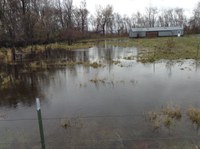Mitigate the Impact of Flooding in Rural Areas
(Click the image below to view a high-resolution image that can be downloaded)
The National Weather Service flood forecast is for moderate snowmelt flooding somewhat above long-term historical averages across the Red River and Devils Lake Basin. This may cause flooding in some rural areas. Now is the time to prepare before water accumulates on the farmstead or to observe water ponding and where it flows to plan strategies that reduce future problems.
North Dakota State University (NDSU) Extension experts offer the following advice on how to protect your home, farmstead, livestock and stored grain:
- Test your sump pump to make sure it is operating properly.
- Move snow away from building foundations if it is more than a couple feet deep. Each cubic foot of piled or packed snow contains almost 3 gallons of water.
- Assure that downspouts carry water several feet away from the house or other structures. Six inches of compacted snow on 1,000 square feet of roof is about 1,200 gallons of water.
- Move valuables, such as photos, tax records, insurance policies and household inventories to higher locations.
- Move hazardous material such as agricultural chemicals, paint, oil and cleaning supplies to higher locations.
- Have an emergency power source, such as a standby generator.
- Verify adequate drainage around the farmstead and grain bins.
- Move machinery, feed and grain to a higher elevation if necessary or assure that water flows away from structures.
- Assure that livestock have access to higher dry ground.
- If your septic system’s drain field will become flooded or saturated, plug all basement drains and drastically reduce water use in the house. Unbolt toilets from the floor to plug the outlet pipe.
- Use material such as heavy plastic and duct tape to seal your well cap and top of the well casing if necessary to keep floodwater out.
- Assemble supplies if roads may become impassible.
For more information on preparing for a flood, visit the NDSU Extension flood information website at www.ndsu.edu/agriculture/ag-hub/ag-topics/disasters/flood.
NDSU Agriculture Communication – March 17, 2022
Source: Ken Hellevang, 701-231-7243, kenneth.hellevang@ndsu.edu
Editor: Elizabeth Cronin, 701-231-5391, elizabeth.cronin@ndsu.edu


